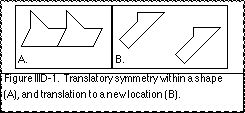
Spatial information can be mentally and physically transformed according to various symmetrical operations. Many types of symmetrical transformations are also used in dance technique and choreography. Choreutic practice includes exercises in transforming kinesthetic spatial information into new variations. Choreutic “scales” consist of kinespheric forms which are symmetrical in three dimensions.
The ability to perform symmetrical transformations is essential for normal everyday spatial cognitive processes. Whenever we move in an environment our memory image of the locations of objects in that environment must likewise be transposed or rotated relative to the location and orientation of our body (Hintzman et al., 1981). When giving directions from a real or imaginary map, one must either physically or mentally rotate the map to fit the environment in order to know the correct (right, left) directions (Hardwick et al., 1976, p. 5). Rotations around two different axes may also be necessary if the map and the environment are not in parallel planes. It is the ability to manipulate spatial knowledge that makes it useful:
. . . the content of a cognitive map really cannot be considered in isolation from its manipulation. The functions of a cognitive map assume the manipulation of internalized spatial information.
. . . [for example, a road map] if one cannot manipulate the map, that is, key it to one’s own location and extract its information, it has no functional value. (Hardwick et al., 1976, p. 4 [emphasis theirs])
Similarly, Piaget and Inhelder (1971) refer to the “figurative” and the “operative” aspects of cognition. The figurative is concerned with static configurations while the operative aspect is concerned with changes from one static figure to the next. In Piaget and Inhelder’s (1967) scheme, children are observed to gradually develop through phases in the ability to perform operations on figural knowledge and thus transform it into new orientations and situations.
Ability to perform rotation, translation, and sizing operations (see below) on visual stimuli is necessary for recognition since objects may often occur in different orientations, in different places (egocentric and exocentric), and will have a larger or smaller visual image depending on their distance from the observer. In all these cases a symmetry operation is necessary for the successful recognition of the object (Rock, 1973, p. 6).
Symmetrical operations also appear to be used to organise spatial information into higher-order groupings. This type of strategy has the effect of increasing verbal memory capacity by remembering a large number of individual items according to a smaller number of groups, “clusters”, or “chunks” of items (eg. Miller, 1956; Tulving, 1962; 1966; Reitman and Rueter, 1980; see IVB.51). Jordan and Rosenbaum (1989) point out that not only do hierarchical groupings allow one to “minimize the load on peripheral memory structures, which have limited storage capacities” but that they are also “convenient structures for the application of transformational rules such as repetition, mirroring, and transposition” (p. 742). This was found to occur in motor memory. Restle and Burnside’s (1972) Subjects learned a movement sequence of 24 fast key-taps on a display of 6 keys. The sequence of key-taps contained a structure which would enable Subjects to organise them into higher-order clusters. For example, the key-tap series might consist of a run up the keys in sequence (#1, #2, #3), a retrograde of that series (#3, #2, #1), successive repetitions of the same key (#6, #6, #6), or alternations between two keys (#5, #6, #5, #6). Subjects’ errors (ie. tapping a key out of sequence) indicated that the sequence of movements were being organised in groups according to the symmetrical relationships amongst its members (ie. most errors occurred at the end of a symmetrical grouping). When another layer of hierarchical structure was available, for example a translation of a series (#1, #2, #3, #2, #3, #4), or a mirror image of a series (6-key display; #1, #2, #3, #6, #5, #4) then the movement sequence is learned easier. This indicates that Subjects search for and use symmetrical groupings among kinesthetic spatial items as a strategy to facilitate memory. Likewise, the time required to initiate a series of key–tapping movements is dependent on the length of the series. However, when symmetrical groupings are present within the series then the reaction time is shortened (Inhoff et al., 1984).
Memory groupings based on symmetrical transformations correspond to other hierarchical models of motor memory and speech movements in which limited storage capacity is accommodated for by grouping individual movements (eg. key-taps) into higher-order clusters based on a “rule” about the transformation that will generate all the members of the cluster (Collard and Povel, 1982; Gordon and Meyer, 1987; Greeno and Simon, 1974; MacKay 1982; Restle, 1970). For example, if an initial item of a cluster is known, then the other members can be derived by applying transformational rules which define the cluster. Keele and Summers (1976, p. 134) concluded from this that symmetrical relationships between movement elements are a basis for developing a hierarchical motor memory structure which can facilitate the learning process.
Clusters of movements may also be defined by a temporal rhythmic symmetry, that is, the relative timing or “phasing” between the elements within the sequence (Martin, 1972). For example, an 8-part series of tones was more easily remembered than a 7-part series of tones, presumably because the 8-part sequence could be more easily divided into two equal 4-part series, but this symmetry is not possible with a 7-part series (Sturges and Martin, 1974).
The notion of symmetry is often used to refer to bilateral reflection symmetry. While this may be predominate because of the bilateral symmetry of the body structure (see below) it is only one out of many types of symmetrical transformations (see reviews by Holden, 1971; Wechsler, 1990; Weyl, 1952). A review of symmetrical transformations in spatial cognition and motor control tasks, and within dance and choreutic practice, has distinguished the following types of symmetry:*
| Body symmetry: | Transferring the form to different body-parts |
| Spatial symmetry: | Translation to a different area |
| Reflection across any plane | |
| Rotation around any axis | |
| Retrograde the previous motion (end-to-beginning) | |
| Size scaling (enlarge or reduce the overall size) | |
| Temporal symmetry: | Velocity and overall duration |

Translations can also be conceived across time in which a form might be reproduced at a later moment. If time is considered to be the fourth dimension, then time itself can be conceived as a continual translation process in which items occur again and again in new temporal locations.
A basic example of translatory symmetry in body movement are the parallel paths of eye movements which occur when both eyes observe a moving object or scan across space while the eyes remain focused at a fixed distance from the Subject. In this case the movement of one eye follows a parallel path to the movement of the other eye (Hallett, 1986).
Common translation symmetries in dance are when two different dancers perform the same form, or when one dancer performs a form and then moves to a new place to perform it again. Translations also occur in ballet technique when a leg movement might be executed low with the toe touching the floor (eg. “Rond de jambe á terre”) or translated higher with the entire leg in the air (eg. “Rond de jambe en l’air”) (Grant, 1982).
Translation symmetry in body movement typically occurs together with body transfer and sizing transformations. Therefore, particular examples of these are discussed as combined transformations (see IIID.25).
IIID.24 Size Scaling: Reduce / Enlarge.
Spatial forms can be reproduced as larger or smaller versions of the original. This adjustment of the size of a form can be termed “size scaling” (Sekuler and Nash, 1972) or simply “sizing”. The possibilities are referred to here as “reducing” or “enlarging”.
Size scaling spontaneously appears in illusions such as the perceived enlarging or shrinking of a briefly presented visual object. This “gamma movement” indicates that size scaling is an automatic visual process (Arnheim, 1974, p. 438; Lindemann, 1922).
The greater the size difference between two rectangles, the more time is required to decide whether they are the same or different shapes. This indicates that a mental image of the rectangles is transformed so that they are imagined at the same size before comparing their shapes. When the two rectangles are not in the same orientation then even more time is required (presumably for mental rotation) in addition to the time required for size scaling (Sekular and Nash, 1972). This addition of the times required to mentally transform the orientation and size of the figures has been observed by others (Bundesen et al., 1981) and indicates that sizing and mental rotation are distinct transformational processes which each require their own processing time.
The overall temporal duration appears to be the principal mechanism in size scaling of kinespheric forms. Wing (1978) observed that when letters are written larger that the time required to write the letters increases. This increase in the overall duration of time is termed “time scaling” (p. 156) and appears to be the temporal counterpart to size scaling. Later, Wing (1980) demonstrated that when words are written larger that all letters require about 25% longer duration to write. Enlarging the size of hand cranking movements (rotating either forward or backward in the medial plane) also did not cause any changes in the relative timing (phasing) of the actions of six arm muscles (Glencross, 1973a; 1973b). This indicates that the same basic movement is being produced regardless of the size.
Size scaling can be identified within ballet technique. Many movements occur as a small variation (eg. “petit Assemblé”) and also can be transformed into a large variation (eg. “grand Assemblé”) (Grant, 1982). The differently-sized movements are basically the same motor action, one variation simply executed with more expansive movements than the other.
Size scaling typically occurs together with body transfer and translations. Therefore, particular examples of these are discussed as combined transformations (see IIID.25).
IIID.25 Combined Body Transfer, Translation, and Size Scaling.
Body transfer, translation, and sizing transformations of kinesthetic forms typically occur together. Changing the size of a kinespheric form is accompanied by a body transfer (different muscular use) and the form is often also translated to a new location.
An occasional example occurs in dance classes (especially ballet) when a dancer rehearses leg movements of a dance sequence by mimicking their directions with hand movements (personal observation). The body transfer, size scaling, and translation from hand movements to leg movements and vice versa appears to be accomplished effortlessly and to be a useful strategy for learning and memory.
Handwriting forms have been observed to occur in an identical style regardless of the size of writing, body transfers and translations (Bernstein, 1984, pp. 106, 109; Merton, 1972, p. 32; Raibert, 1977; Smyth and Wing, 1984, p. 12; Wing, 1980). Similarly, Bernstein (1984) observed that forms can be produced anywhere in the “motor field”. This translation symmetry would also include a body-transfer since different muscles are used when the form is produced in a different location:
. . . the process of carrying out a habitual action, for example, writing a word or playing over a passage which one has learnt by heart on the piano, is carried out with approximately the same facility and with the same degree of accuracy independently of the position of the hand [on the paper] or of the register on the piano. (Bernstein, 1984, p. 107; also noted on p. 109)
Morasso (1986, pp. 23-24, 34-35) recorded hand and shoulder trajectories when the target for hand movement was beyond arm’s length. To increase the reach of the arm the shoulder may be displaced in the direction of the hand, or the entire body may be transported by stepping. In both cases the shape of the spatial trajectories and the pattern of velocities revealed that the shoulder movements were reduced and translated versions of the hand movements, that is, “the trajectory of the shoulder ‘mimics’ the trajectory of the hand” and “the trajectories of the shoulder are a more or less distorted version of the hand trajectories” (p. 34). Both the hand and the shoulder were spontaneously creating the same kinespheric form, regardless of the body transfer, sizing, and translation.
A combination of size scaling, translation, and body transfer can also be identified in tasks which require Subjects to walk through a floor pathway and later draw that path on a piece of paper. This task is performed easily (Levine et al., 1982, p. 160) and requires a reduction of the path size, a translation from the room to the paper, and a transfer in the body parts which produce the path.
The freedom for body transfer, sizing, and translation of kinespheric forms is described by Bernstein’s (1984, pp. 110-117) “principle of equal simplicity” which essentially posits that if two operations are equally “simple” to produce (eg. equally accurate, equally fast), then the apparatus must be producing them similarly. Bernstein observes that the “trace” of movement paths can be transformed in various ways (eg. size scaling, translation) and that the transformed movement can be executed as simply as the original (pp. 106–109). The body-use can differ greatly between different transformations, however the exterior spatial form is nearly identical. Therefore, according to equal simplicity, it is logical to assume that all of the transformations are produced by the same movement memory code which is based on the exterior spatial form rather than particular muscles. Bernstein calls this memory code the “higher engram” which is the “engram of a given topological class” and “it is extremely geometrical, representing a very abstract motor image of space (p. 109):
The almost equal facility and accuracy with which all these variations [symmetry transformations] can be performed is evidence for the fact that they are ultimately determined by one and the same higher directional engram. (Bernstein, 1984, p. 109)
This allows us to conclude with a high degree of probability that the structure of the central complex which governs the production of a given series of movements is much more closely related to the spatial form than to muscle scheme. (Ibid, p. 114)
This is also discussed in terms of “the principle of motor equivalence” whereby the motor representation is “largely independent of the specific sets of muscles involved in the actual performance” (Morasso, 1983a, pp. 208-209; also Saltzman, 1979, pp. 94, 103). The ready performance of body transfers, sizing, and translation indicates that kinespheric forms are remembered in a format which is free from any particular body usage, size, or location.
Smyth and Colleagues (Smyth et al., 1988; Smyth and Pendleton, 1989; 1990) also identified a type of body-part free spatial representation. They used dual-task interference studies (see IIC.10) to distinguish between movements to a “location of a target in space” which can be mentally represented “without specifying which effectors [body-parts] are to be used to reach those targets” versus movements consisting of a “configuration of the body parts themselves” which must be represented in a format specific to the body-parts used (Smyth and Pendleton, 1990, p. 292). These type of “locational” movements would have a body-part free representation and so would be easily transferred to new body-parts while “configured” movements would have a body-part specific representation and so would not readily be transferred to new body-parts.
Body transfer, sizing, and translation of kinespheric forms appear to occur at a secondary, lower level in motor planning than changing the directions (eg. reflection or rotation) of a form. If the direction of a movement is known but the size or body-use is not, there can be a short reaction time to initiate the movement after the size and body-use are indicated. However, if the size and/or body-use is known beforehand but the direction is not, then the reaction time to initiate the movement after the direction is indicated will be longer. This indicates that the movement direction must be known first, whereas the size and body-use can be specified at a later stage in the movement preparation process (Larish and Frekany, 1985; see IIIB.54).
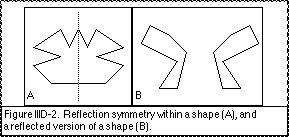
IIID.26 Reflection Symmetry.
“Reflection” refers to a mirror-image reversal, defined as a “transformation in which the direction of one axis is reversed or changes the polarity of one of the variables” (Collins, 1986). This is sometimes referred to as “inversion” in choreography studies (Blom and Chaplin, 1982, p. 102). A plane of reflection symmetry (the dashed line) passes through the shape in Figure IIID-2A and a shape has been reflected to produce a new variation in Figure IIID-2B.
Convergent and divergent eye movements are simple examples of bilateral reflection symmetry by the kinesthetic perceptual-motor system. When a visual focal point is moving closer the eyes will rotate towards each other (convergence) and when the focal point is moving away the eyes will rotate away from each other (divergence) (Hallett, 1986). In both cases the movement of either eye is a right/left reflection of the other.
Reflections can occur across a plane of reflection symmetry in any orientation, however bilateral right/left reflections across the median plane are the most typical. Children often make bilateral right/left reflection errors when learning to write (Bernstein, 1984, p. 108). It is typically suggested that the dominance of bilateral reflection symmetry in human cognition is related to the bilateral symmetry present within the human body (Rock, 1973, pp. 19-20). Corballis and Beale (1970) review this general tendency in children, adults and other animals to have confusions between right and left and conclude that this may be accounted for by the right/left symmetry of the nervous system. A perfectly symmetrical machine could not tell right from left, thus, the ability to distinguish left from right is indicative of an asymmetry within the system.
A “switched-limb” condition has been used in spatial positioning tasks in which the movement and final location are learned with one arm and then recalled with the other arm. The switched arm may recall the final location with the same direction of movement (body transfer only), or with the opposite direction of movement (body transfer and left/right reflection). In many cases recall of the final location is just as accurate in the same or reflected direction of movement. These results have been used to support the location code for the mental representation of the kinesphere (Larish et al., 1979; Larish and Stelmach, 1982; Stelmach and Larish, 1980; Wallace, 1977; see IIIB.12).
A common effect associated with reflection symmetry and body transfers is when a kinespheric form is transferred to the other body-half then Subjects will spontaneously also perform a right/left reflection of the form. This is typical in dance classes when students perform a movement routine on “the other side”. Laban also observed this effect:
[A person] understands his mirror-like symmetrical movements of left and right sides [of the body] to be identical, although their inclinations are completely different. When someone follows [a particular pathway] with the right arm . . . and is asked to repeat the same movement with the left arm, he will not follow the same trace-form, but [instead will follow] its mirrored form. (Laban, 1966, p. 79)
The direction of a rightward movement is different than a leftward movement. However, a rightward movement with the right body-side and a leftward movement with the left body-side both produce similar bodily sensations of widening in the torso. The sensation of narrowing when moving across one’s body versus widening when moving away from the medial plane appear to be more significant for the mental representation of movement than the left/right structure of the form. Because of these problems with right and left, some authors refer to kinesthetic forms as widening/narrowing or inwards/outwards rather than right and left (Laban, 1966, p. 38).
In addition, the conceptual distinction of right versus left may be arbitrary. In Weyl’s (1952) famous work, forms of “screws” and the concepts of “right” and “left” are scrutinised in the context of geometry, physics, biology, chemistry, and astronomy (pp. 16-38). In all cases no objective basis is found for distinguishing right from left but that “the inner structure of space does not permit us, except by arbitrary choice, to distinguish a left from a right screw” (p. 17). However, it is pointed out that mythical thought in art, magic, and religion consistently separate “rightness” as referring to correctness and truth, from “left-handed” as referring to evil (from the Latin sinister ; on the left).
In the case of printed words right/left or up/down reflections make the word harder to recognise than rotations (Kolers, 1968; Kolers and Perkins, 1969a; 1969b) and so the mental representation of these forms can be considered to be reflection-specific. However, other stimuli such as inkblots can be recognised better with a right/left or an up/down reflection than if they are rotated 90° (Rock, 1973, pp. 98-100). These figures contain a structure which appears relatively similar when reflected, but dissimilar when rotated and so their mental representation can be considered to be reflection-free.
IIID.27 Rotational Symmetry.
Rotation refers to turning a form around an axis to a new orientation and is defined as:
A circular motion of a configuration about a given point or line, without a change in shape. . . . A transformation in which the coordinate axes are rotated by a fixed angle about the origin. (Collins, 1986)
For example, an axis of rotational symmetry (indicated by a dot) can be identified perpendicular to the page and passing through the shape in Figure IIID-3A . The shape can be rotated around this axis and appear identical before a full rotation has occurred. The shape in Figure IIID-3B has been transformed by rotation (and translation to a new place).
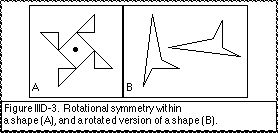
In their classic article Shepard and Metzler (1971) identified a linear relation between the time required to compare two figures and the degree to which they are in different orientations. It is concluded that the increased time is required to mentally rotate one of the figures into the same orientation as the other figure where their shapes can be compared.
Further characteristics of mental rotation have been probed (Cooper and Shepard, 1984; Kosslyn, 1980, pp. 305-329). The time required to compare two figures in different orientations can be shortened by informing Subjects about their orientations beforehand (Cooper and Shepard, 1973). The time that Subjects require for this imagery preparation also increases linearly with the amount of mental rotation required (Cooper, 1975; Cooper and Podgorny, 1976). The linear relation between difference in orientation of two figures and the and time required to compare their shapes is sometimes constant regardless of their complexity (Cooper, 1975; Cooper and Podgorny, 1976) but the mental rotation time is also relative to the amount of practice with the stimuli, the type of complexity, and the type of comparison task (Barfield and Salvendy, 1987; Bethell-Fox and Shepard, 1988; Pylyshyn, 1979).
Mental rotation effects also occurred for congenitally blind Subjects who compared the shapes of figures through tactual (kinesthetic) perception (Carpenter and Eisenberg, 1978; Marmour and Zaback, 1976). This indicates that mental rotation is an abstract spatial process independent from any particular sensory modality.
Kinespheric forms may sometimes be readily rotated. For example, turning a hand crank forward (from the top) in the medial plane can be perceived as “familiar in that the movement is a natural extension of winding or cranking in the frontal plane” (Glencross, 1973b, p. 215). In this case the winding cyclic movement of the arm-hand remains essentially identical whether it is oriented in the medial, frontal, or any other plane.
A rotational transformation commonly occurring in ballet is known as “En Croix ” (“in the shape of a cross”) (Grant, 1982, p. 36) in which a kinespheric form (eg. an extension of the leg) is executed towards the front of the body, then to the side, and finally is executed towards the back of the body. Any kinespheric form can be rotated relative to the room simply by changing the (exocentric) orientation of the body.
In many cases spatial forms may be recognisable or producible only in certain orientations. This indicates an orientation-specific representation. The classic example is a four-sided equilateral, equiangular polygon which is referred to as a “diamond” in one orientation and a “square” when in another orientation. In the classic work by Rock (1973) this example and others are reviewed in which visual forms are readily recognised only in their typical orientations. When a form is not in its typical orientation then a process of “correction” (p. 49) occurs where the form is mentally rotated until it can be recognised.
Orientation-specificity also occurs for kinespheric forms. For example, kinesthetic (tactual) perception of objects which were learned in a fixed orientation and tactual perception of familiar objects usually experienced in a particular orientation were difficult to recognise when their orientation was changed (Rock, 1973, pp. 34-36).
Written letters and figures also may have an orientation-specific representation. For example, Bernstein (1984) notes that “it is extremely difficult to draw figures upside down with a pencil” (p. 107), and that while children often make right/left reflection errors while learning to write that “they never turn the letter upside down” (p. 108). Another example is found in the sport of American baseball. The speciality of the pitcher is to throw the ball extremely accurately over “home–base”. However, when the pitcher (rarely) throws the ball in a different direction it can often be inaccurate. A pitcher’s kinesthetic-motor knowledge is often specific to the single orientation in which the vast majority of practice has been undertaken. Baseball announcer Ron Fairly has commented about this:
Why is it that a pitcher can stand on the mound and make pitch after pitch so perfect all day long, but let him throw it in any other direction and they don’t know where it’s going. (Fairly, 1995)
Levine and Colleagues (1982) probed evidence for an “orientation corollary” which posits that at any particular time the mental representation of a spatial environment (“cognitive map”) has a specific orientation (p. 168). Their Subjects learned a pathway on a 50cm2 card by visual-motor observation or (blindfolded) arm-hand movement. In all cases the card remained in a single orientation throughout learning. Subjects then transformed this path into a locomotor-space by walking through the room (enlarging, body transfer, and translation). Occasionally a “contraligned” condition forced Subjects to recall the pathway in an orientation rotated 180° from how it had been learned. This forced a mental rotation of the pathway and recall was much more difficult (p. 172) indicating that Subjects had learned an orientation specific representation of the path.
Orientation-specificity appears to be the outcome of learning the spatial information from a single orientation, whereas orientation-freedom can develop when the space is explored from many different perspectives. Learning a room-sized path (100cm x 350cm) by seeing paper-sized maps of the path in a single orientation led to (blindfolded) direction judgements (using an apparatus to point between locations along the path) which were most accurate when made facing a particular orientation (orientation-specific). However, when the path is learned by seeing it or walking (blindfolded) along the path (which introduces multiple facings of the body) then direction judgements are equally accurate from any orientation (orientation-free) (Presson and Hazelrigg, 1984). Walking forward or backward along the path (requiring multiple facings) led to more orientation-freedom in direction judgements than learning the path by walking along it and maintaining a constant room facing (Presson et al., 1987). Therefore, multiple orientations during learning appear to produce representations which can freely rotated.
Orientation-specificity and orientation-freedom can also be identified in the time required for mental rotation. More time is required to decide if three U. S. A. states are in the correct arrangement the further away they are from their typical north/south orientation. It is assumed that the states must be mentally rotated into their typical orientation before the decision can be made. An identical effect was found for arrangements of buildings which had been learned from maps. This orientation-specific effect may occur since maps are usually read and learned from a single orientation. Conversely, the reaction time required to decide if three buildings from a familiar campus are in their correct arrangement was not affected by the orientation in which the buildings were presented. This orientation-free effect may occur since buildings on a campus are usually learned by actual locomotion which includes many changes of orientation (Evans and Pezdek, 1980).
Hintzman and Colleagues (1981) used various environments in which Subjects imagined themselves in the centre of a circle and facing one of eight surrounding locations. Another location is indicated and the Subject judges which direction this “target” would be from themselves if they were facing in the imagined “orientation” (by moving a stylus in the appropriate direction from the centre to the periphery of a small, 9 cm diameter, circle). When the orientation and target were indicated by an arrow and a light on a visual display then the typical mental rotation effect occurred; the further the imagined orientation away from straight ahead, the longer the reaction time to judge the direction.
However, Hintzman and Colleagues (1981) also indicated the orientation and target in other ways. In one set-up the locations of drawings were learned in a small (2.5m2) room where Subjects were free to swivel in a chair into all orientations. In another set-up the locations of drawings were learned which were mounted on an octagon and rotated (for viewing from all angles) in the frontal plane. The drawings in both set-ups served to indicate the imagined orientation and the target towards which direction judgements are to be made. In these cases there was no mental rotation effect. The time required to judge the direction toward a target was identical regardless which orientation the Subject imagines facing. All facings were equally free to be used since the environment had been learned from many orientations. However, when the drawings in the room were learned from only one orientation; or eight U. S. A. cities were used as locations (typically learned from a map in one orientation); then mental rotation effects occurred, indicating an orientation-specific representation.
Subjects as young as five years old can accurately align a “sighting tube” in the direction towards four locations in a large well known room (‰ 30’ x 50’) regardless of the orientation they are facing (orientation-free). Adults are able to combine this rotational transformation together with imagining oneself to be standing at a different place in the room, or imagining that the entire room was rotated. This indicates that a high degree of free transformations are possible in a well learned environment and well developed Subjects (Hardwick et al., 1976).
This research has indicated that multiple orientations experienced during learning lead to an orientation-free mental representation. As a spatial environment is explored from many orientations, its mental representation becomes more and more orientation-free.
IIID.28 Retrogradation.
When a sequential spatial form (pathway) is learned from beginning-to-end, it might then be recalled from end-to-beginning. The order in which the path was learned might be termed the “original order” and the retracing of one’s motions in reverse can be referred to as “retrograde”. The concept of retrograde is not typically included within symmetry studies but it can be identified as a usable transformation, is listed as a choreographic device (Blom and Chaplin, 1982, p. 102) and is also used in music to refer to a melody which is played backwards (Collins, 1986).
Retrograde transformations are sometimes used in spatial cognitive and motor control studies. One difference between forward or backward hand cranking (Glencross, 1973b) is that they are retrogrades of each other. Subjects could recall pathways with arm-hand movements or locomotor movements equally accurately in their original or retrograde orders (Levine et al., 1982, pp. 164, 166, 169).
A complete and explicit understanding of symmetrical transformations can provide a clearer analysis of transformations which are required in spatial cognitive tasks. As spatial cognition research has become more complex so have the transformations required by the spatial tasks.
For example, in visual imagery experiments by Attneave and Farrar (1977) the transformations can be defined according to egocentric and exocentric symmetries. Control Subjects were not required to perform any transformations relative to egocentric or exocentric space. Other Subjects either rotated the body together with the visual image in exocentric space (equivalent to no transformations in egocentric space) or rotated the body and translated the image through exocentric space (equivalent to an image rotation in egocentric space).
In some cases the exact movement directions and end locations of switched-limb spatial positioning tasks (Larish et al., 1979) or mental transformations required in cognitive map tasks (Hardwick et al., 1976) are not clearly described. These spatial transformations need to be explicitly stated in an agreed upon language to encourage clarity in discussions of spatial cognition.
Other problems with terminology are evident. Stelmach and Larish (1980; Larish and Stelmach, 1982) write about “limb orientation” within a switched-limb spatial positioning task. This use of “orientation” fails to identify that the only thing being tested is recall of the location of the limb’s distal end (the locus of the handle on the positioning apparatus). For a single limb the orientation may (but not necessarily) be the same each time the location of the distal end is recalled. But when different limbs recall the same location of the distal end, the orientation of the two limbs will necessarily be different. The limb’s orientation, which can be transformed by rotation, needs to be distinguished from the distal end locus, which can be transformed by translation.
Describing the turning of a hand-crank as either “forward” or “backward” within the medial plane (Glencross, 1973b; 1975) contains an implicit assumption of forward or backward from the top of the crank. Either direction of cranking has both a forward and a backward component. One direction turns forward from the top of the crank and backward from the bottom, and vice versa for the other direction. A similar assumption occurs in the instructions to turn a knob or screw towards the right or towards the left (eg. “lefty–loosey, righty-tighty”*). The implicit assumption is left or right from the top. In the interests of precision these implicit assumptions should be explicitly stated.
__________
* A traditional rhyming mnemonic used to remember which direction to loosen or tighten a knob or screw. Told to the Author in Eugene, Oregon by Kim Christensen.
___________
As discussed above, there is not a standard language for describing kinesthetic spatial symmetry transformations and these are often not explicit in spatial cognition research. This same gap in the knowledge can be found in dance studies. The types of symmetry outlined above can serve as a basis for clarifying the conception of symmetry operations in dance.
Wechsler (1990) gives a brief introduction to symmetry in dance with a few examples of body poses analysed according to “point groups”, “line groups”, and “plane groups” with translation, reflection, and rotation symmetries. The concept of “approximate symmetry” is introduced according to which symmetries are identified across body parts in an approximate way, for example, the two legs as an upwards/downwards reflection of the two arms.
In a review of the movement theories of Francois Delsarte (1811–1871) Shawn (1954, pp. 33-35) recounts the “Three Great Orders of Movement” consisting of oppositions, parallelisms, and successions. “Oppositions are defined as any two parts of the body moving in opposite directions simultaneously” and so are identical to reflection symmetry together with body transfer. “Parallelisms are defined as two parts of the body moving simultaneously in the same direction” and so are identical to translation symmetry together with body transfer. “Successions are defined as any movement passing through the entire body, or any part of the body, which moves each muscle, bone, and joint as it comes to it” (italics his). This appears to be identical to a movement being transferred across a series of adjacent body parts.
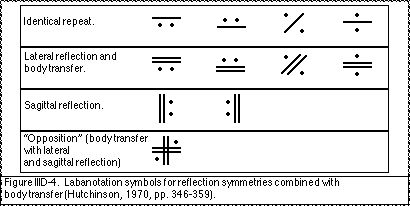
In their choreography textbook, Blom and Chaplin (1982) consider “symmetry” only as referring to right/left reflection symmetry (pp. 38-41). Later they list a variety of “ways to manipulate a motif” (pp. 102-104). These include “repetition” which consists of a translation symmetry across time, and possibly also to a new place in space; “retrograde” which is identical to the retrograde transformation discussed here; “inversion” which refers to an up/down reflection symmetry, and; “size” which is identical to size scaling discussed here.
A few specialised symmetries are used in Labanotation (Hutchinson, 1970) which have corresponding notation symbols (Fig. IIID-4). The symbol for an identical repeat of a previous movement is adopted from musical notation. Doubling the line in the symbol indicates “‘the other side’ . . . a laterally symmetrical repeat” (pp. 346, 354, 357) (an option not found in music) which consists of the typical right/left body transfer together with a right/left reflection (see IIID.26). The symbol for “sagittal symmetry” specifies a reflection where all forward directions become backwards and vice versa (but without any body transfer) (pp. 354, 358). The lateral and sagittal symmetries can also be combined into a single “oppositional symmetry” symbol (eg. used when two people face each other in ballroom dancing) (p. 354, 359).
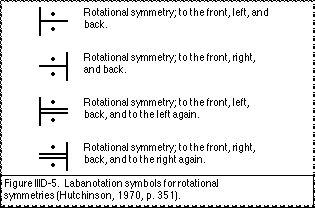
Symbols have also been developed to specify ballet “En Croix ” repeats (Hutchinson, 1970, p. 351). In these rotational symmetries a movement is performed to the front of the body, to the side, and then to the back (see IIID.27). A modification to the symbol is introduced to indicate that the movement is then performed again to the side (as often occurs in ballet exercises) (Fig. IIID-5). These symbols were developed to specify this rotational symmetry around the vertical axis in ballet and consequently they are not easily adapted for rotational symmetries around other axes.
Symmetrical transformations of kinespheric forms are fundamental to choreutics. The terminology used is often variable, but an implicit knowledge of symmetries is embodied within the choreutic scales.
Preston-Dunlop (1980, p. 182; 1984, p. x) uses “transposition” to refer to reflection symmetries. The term “harmonic opposite” (1984, p. viii) is also used to refer to a reflection across all three dimensions. Ullmann (1966) uses the notion of a “transposed” movement to refer to a movement translated to a new place (p. 146) or translated and also reduced in size (p. 172). The notion of an “inverted” movement is also used to refer to a retrograde (p. 165).
Laban (1966) uses “degrees of extension” to refer to size scaling transformations in which a spatial form can be performed in a “shrinking and growing kinesphere . . . [which] makes it possible to describe innumerable variations of trace-forms” (pp. 41-42). Later this size scaling is referred to as “transposing a trace-form” (p. 113).
Laban (1966) also describes how one can “transform” a dynamic sequence (eg. a sequence of movement qualities such as punching, gliding, and slashing) by “enlarging and transferring” it to create a spatial sequence (p. 60). This dynamic/spatial transformation is not encompassed within the conception of symmetry transformations presented here.
Choreutic “scales” and “rings” are composed of symmetric divisions of three-dimensional space and a large number have been illustrated and notated (Preston–Dunlop, 1984). Because of this symmetry choreutic practice can be considered to be exercises in producing and transforming a variety of symmetrical divisions of space.
At the basis of Laban’s (1966) conception of spatial “scales” is that they are derived from body movements which strive to maintain equilibrium. These often create symmetrical patterns and so are considered to be “harmonious”:
A most important way of attaining what we call equilibrium is found in the so–called movements of opposition. When one side of the body tends to go into one direction, the other side will almost automatically tend towards the contrary direction. We feel the loss of equilibrium and produce, often involuntarily, motions to re-establish balance. . . .
The wish to establish equilibrium through symmetric movements is the simplest manifestation of what we call harmony; the aim of this is . . . to achieve a unity of form, a wholeness, a completeness. (Laban, 1966, pp. 89-90)
Laban noted the frequency relations among visual and audio vibrations as a model for identifying harmony in bodily movement:
Relations of vibrations expressed in primary numbers give our senses an impression of balance which we call harmony. For instance, the octave in music has the relation 1:2 which means that the vibrations of the high octave are twice as many as the lower one. There is also a numerical relationship between the primary colours of red, blue and yellow and it is the purpose of this investigation to point out the possibility of discovering similar relations in the trace-forms of movement. (Laban, 1966, p. 29)
Symmetrical movements to re-establish balance do not exhibit a simple reflection symmetry but a sequence of asymmetrical movements which, as a whole, complete a symmetry. Laban (1966, p. 90) refers to this as “Equilibrium through asymmetric movements”, that is, many choreutic scales consist of “asymmetric movements which must necessarily be completed by other asymmetric tensions or moves” to arrive at an overall symmetrical pattern.
This description by Laban is identical to the concept of “dynamic equilibrium” within kinesiological studies in which each movement serves as a balancing reaction to the last movement:
After an unbalancing movement is perceived, some motion is initiated to counterbalance it and move the centre of gravity of the body back over the supporting base. Typically, this countermovement is too great, producing an unbalancing movement in the opposite direction. This calls again for detection and countermovement. As the process is repeated, oscillation occurs. (Rasch and Burke, 1978, p. 102)
Laban’s conception of dynamic equilibrium is rooted in the plastic nature of space in which balancing movements must counteract the tendencies toward three dimensions simultaneously:
The three-dimensionality (plasticity) of our body requires that each true equilibrium placement shall be tensioned in three directions over the supporting vertical. The most stable condition is given if the three swinging body-quarters [ie. three limbs] are each directed into one dimension. (Laban, 1926, p. 17)
Mechanical equilibrium is typically measured and graphically depicted in two dimensions but it is understood that this is only to simplify the problem and that equilibrium forces will always be in three dimensions during an actual event (Dempster, 1961; see Appendix XV.11). Likewise, Golani (1986) argues that the full three dimensional plastic attributes of body motion patterns need to be considered rather than the planar analysis typically found in motor control studies. A conceptual planar analysis can never fully depict actual plastic body motions.
Laban (1926) states this within the “law of countermovement” in which the movement to maintain equilibrium consists of “moving towards a nearly opposite spatial-direction” (p. 18 [italics mine]). In terms of the choreutic scales the initial move and the following countermovement are described as a “preparation-swing” which occurs before each “primary direction” and that “in fact this preparation-swing lies in a completely particular specific direction and not exactly opposite the primary direction” (p. 29 [italics mine]). This plastic conception of body movement results in choreutic scales which continually transition from one dimension to another.
Similarly, Preston-Dunlop (1989) states that in a spatial scale “you go up so that you may go down”. Bartenieff and Lewis (1980, p. 29) also describe how scales “are not mere lines of different design written into space; [but that] they reflect the condensations and expansions of body-muscle-spatial patterns”. In accordance with dynamic equilibrium patterns “The sequence of the scale is ordered for the easiest shifting from one direction to another”.
Because of these exercises in symmetrical patterns of dynamic equilibrium, choreutic scales are sometimes thought of as a “prescriptive” system of movement training. The three-dimensional symmetrical patterns within the “scales and rings are thought to give practice over the whole range of spatial possibility”, and for choreutics, this is a “practical test of validity” (Salter, 1977, p. 138).

Some of the principal choreutic scales are identical to symmetric solutions for Sir W. R. Hamilton’s “The Icosian Game” (invented around 1850) which set up a problem of traversing through a given set of polyhedral corners, visiting each corner only once, and ending at the same point at which you began (Hankins, 1980, pp. 339–343; O’Donnell, 1983). Hamilton used a dodecahedron (20 corners, 30 edges) but any polyhedra could be used. This is similar to a geometrical problem presented earlier by Leonard Euler (around 1750) about “whether it was possible to take a walk in the town of Koenigsberg in such a way as to cross every bridge in it once and only once” and to return home at the end (back to the original starting place) (Ball, 1905, p. 167). The bridges become the places to be traversed once and only once while moving through the city.
Choreutic symmetry can be distinguished within a sequence and between different sequences. Within each scale or ring the sequence of movements create a symmetrical pattern and so the entire shape of the scale or ring exhibits (for example) axes of rotational symmetry and planes of reflection symmetry. In addition, each scale, ring, or shorter sequence within a scale, is distinguished in one orientation and then reflected and rotated into all possible orientations. The symmetry within and between choreutic scales and rings has been described and graphically represented in many places (Laban, 1966, pp. 68-82; Preston-Dunlop, 1984; Ullmann, 1966, pp. 152-170). However, because of the complexity of three-dimensional symmetry and the variety of terminology used, descriptions of symmetry relationships among the scales and rings has not been integrated into a complete picture.
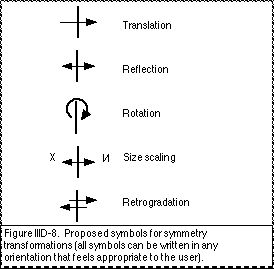
Notation symbols are devised here to aid in concisely and explicitly analysing symmetries present in spatial cognitive tasks, dance and choreography transformations, and choreutic scales. These symmetry symbols may be more cumbersome for certain applications (cf. en croix in Fig. IIID-5 versus Fig. IIID-13) but they are designed for broad and encompassing application rather than to only represent a few special symmetries. These symbols are pictographic, their figures visually resemble the symmetries they represent. They might therefore be more easily used by the dancer or lay person than a more computational abstract representation (eg. letter abbreviations or numbers).
A single stroke can be used as the basic symbol for an “item” (Fig. IIID-6). This might be thought of as similar to the “action stroke”, referring to “any action” in Labanotation motif writing (Hutchinson, 1970, p. 24; Preston-Dunlop, 1969, p. 6). The stroke might also be conceived as the salient axis of a figure or object which is likely to be used as the primary axis in its mental representation (Marr, 1980; Marr and Nishihara, 1978; see IVB.26). An arrow pointing in any direction is taken as a general symbol for symmetry (Fig. IIID-7). The arrow implies the action of transformation whereby new variations of a form are generated. The action stroke and the symbol for symmetry are combined to indicate the different types of symmetry (body transfer is considered to be a type of translation) (Fig. IIID-8).
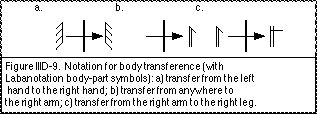

The symmetry symbols can be used in a general way or can be made more specific by adding Labanotation symbols. Body transfers can be notated as a translation symmetry across body-parts (Fig. IIID-9). Symbols for reflection symmetry can indicate the dimensional components which are reversed in the reflection (Fig. IIID–10). Either reduction or enlargement can be indicated in size scaling (Fig. IIID-11). The axis of rotational symmetry can be indicated on either end of the action stroke (Fig. IIID-12). In all cases the symbols might be written in any orientation, and the arrow in any direction, that feels appropriate to the situation.

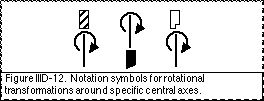
Notation symbols can help make symmetry transformations explicit. Each 1/4 rotation of a kinespheric form in a ballet en croix can be indicated as a rotary transformation around the vertical axis (Fig. IIID-13). The transformation in which dancers “mark” the movement with their forearm-hand and then perform it with their leg can be notated as a body transfer with accompanying enlargement (Fig. IIID–14).

The “A-scale” (Dell, 1972, p. 14; Preston-Dunlop, 1984, p. 67) can be taken as an example of symmetry within choreutic scales. Comparable symmetries can be identified in other scales. Bar-lines are used in Figure IIID-15 to indicate the amount of the scale which is transformed. The amount of the scale which is indicated within the first segment (indicated by the bar-lines) is transformed into the amount of the scale in the following segment. Within the A-scale a “steeple” can be identified in which the second movement is a retrograde and a 1/5 rotation transformation of the first movement (Fig. IIID-15A). This steeple is then transformed into the next steeple by a retrograde and a 2/5 rotation transformation (Fig. IIID-15B). This entire sequence of two steeples is then transformed by a 1/3 rotation transformation to derive the second third of the scale, and rotated again to derive the final third of the scale (Fig. IIID-15C). Alternatively, the second half of the scale (containing three steeples) consists of a three-dimensional reflection of the first half (Fig. IIID-15D).
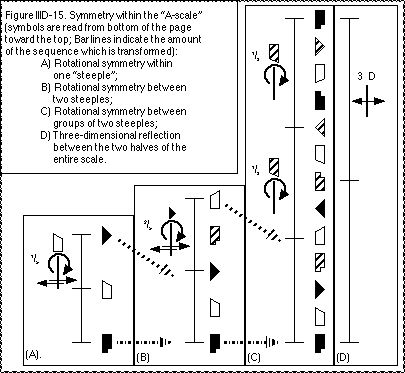
A variety of symmetrical transformations are used within spatial cognition and motor tasks. This ability to perform symmetrical operations is critical for effective everyday use of spatial knowledge (eg. when reading a map which is not in alignment with the actual physical environment). Varieties of symmetry are identified here. Choreutic “scales” are composed of paths and poses with three-dimensional symmetry which are described identically to spatial patterns used while maintaining dynamic equilibrium in three dimensions. The mental conception and physical execution of choreutic scales can be considered to be cognitive and bodily practice in symmetrical transformations and varieties of dynamic equilibrium adjustments.